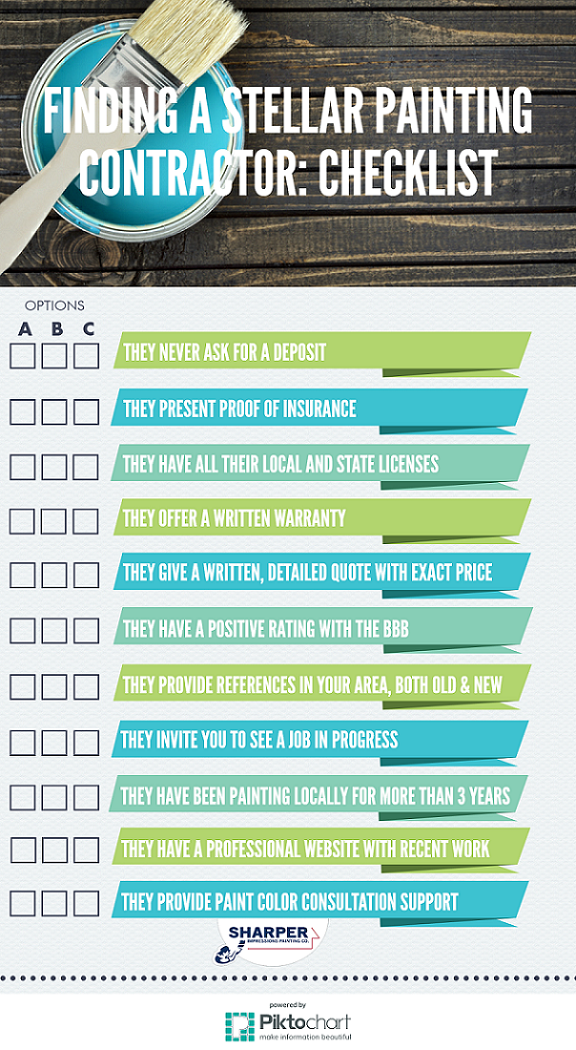Maximizing Tiny Spaces: Painting Strategies To Develop The Illusion Of Area
Maximizing Tiny Spaces: Painting Strategies To Develop The Illusion Of Area
Blog Article
Material Author-
In the world of interior decoration, the art of making best use of small areas with calculated paint strategies supplies a profound possibility to change confined locations right into visually extensive sanctuaries. The careful option of light color combinations and smart use optical illusions can work marvels in producing the illusion of area where there seems to be none. By using these methods carefully, one can craft a setting that defies its physical limits, inviting a feeling of airiness and openness that belies its real measurements.
Light Color Selection
Selecting light shades for your painting can substantially boost the illusion of space within your artwork. Light colors such as soft pastels, whites, and light grays have the capability to reflect more light, making an area feel more open and ventilated. These shades create a sense of expansiveness, making wall surfaces show up to decline and ceilings seem higher.
By using house painters beaverton on both walls and ceilings, you can obscure the limits of the area, offering the impression of a bigger location.
Furthermore, light colors have the power to jump all-natural and fabricated light around the space, lightening up dark corners and casting fewer shadows. This result not only contributes to the general spacious feel however also develops an extra inviting and lively atmosphere.
When selecting light colors, consider the touches to guarantee harmony with other components in the room. By strategically incorporating light shades right into your painting, you can transform a confined room right into a visually bigger and much more inviting environment.
Strategic Trim Paint
When intending to produce the illusion of area in your paint, calculated trim paint plays a crucial role in defining boundaries and improving deepness understanding. By tactically picking the shades and coatings for trim job, you can successfully adjust how light engages with the area, ultimately influencing exactly how large or little a room feels.
To make an area show up bigger, consider repainting the trim a lighter shade than the walls. This comparison creates a feeling of deepness, making the walls decline and the area feel more large.
On the other hand, repainting the trim the same shade as the walls can create a smooth look that obscures the sides, providing the impression of a continual surface area and making the boundaries of the room much less defined.
Furthermore, using a high-gloss surface on trim can show more light, more enhancing the perception of room. Conversely, a matte coating can take in light, developing a cozier atmosphere.
Meticulously thinking about these details when repainting trim can significantly affect the overall feeling and perceived dimension of an area.
Visual Fallacy Techniques
Utilizing visual fallacy strategies in paint can efficiently alter perceptions of depth and room within a provided atmosphere. One typical method is using gradients, where colors change from light to dark tones. By using a lighter color on top of a wall and gradually darkening it in the direction of all-time low, the ceiling can appear greater, creating a sense of upright area. Alternatively, repainting the flooring a darker shade than the wall surfaces can make it seem like the area extends better than it actually does.
One more optical illusion technique involves the strategic placement of patterns. Straight stripes, as an example, can visually broaden a narrow area, while vertical red stripes can elongate a space. Geometric patterns or murals with perspective can also deceive the eye right into perceiving more depth.
Furthermore, integrating reflective surface areas like mirrors or metal paints can bounce light around the area, making it really feel extra open and roomy. By masterfully employing these optical illusion strategies, painters can transform small rooms right into aesthetically large locations.
Final thought
Finally, critical painting strategies can be utilized to make best use of tiny rooms and develop the impression of a larger and extra open area.
By picking visit the up coming post for walls and ceilings, utilizing lighter trim shades, and integrating visual fallacy techniques, assumptions of deepness and size can be manipulated to transform a little room right into a visually bigger and more inviting setting.
